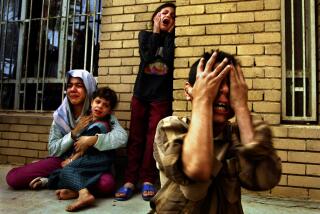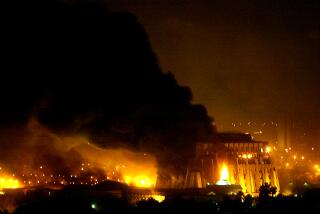Keeping Clash From Culture
- Share via
KUWAIT CITY — It was an odd comment for a military briefing, the lieutenant colonel in his camouflage uniform complaining that Iraqi soldiers were attempting to “take advantage of our cultural sensitivity.”
Yet such is the fine line U.S. and British forces say they have negotiated in the war against Iraq.
More than two weeks into the fighting, commanders say their troops have succeeded in rolling over the enemy while preserving historical sites in a land often referred to as the cradle of Western civilization.
Precision bombs have leveled government complexes while avoiding museums. Everyone from pilots to artillery commanders to tank drivers, they say, is advised about historical sites during briefings. A few days ago in Najaf, troops came under attack from Iraqis hiding in a revered mosque and did not return fire.
But even as Army Lt. Col. John Kuttas boasted of such restraint before reporters Saturday, he acknowledged that it becomes tougher now that tank commanders are rolling through the chaotic and hostile streets of Baghdad.
“That’s the danger if someone is tired and scared,” the civil affairs officer said. “He may have been told this corner has a facility that is 2,000 years old, but he may not remember that, particularly if someone is shooting at him.”
There has been only mild criticism so far, from some wondering why the Americans and British chose to bomb Baghdad palaces that predate Saddam Hussein’s reign.
Although officials didn’t address that question, Kuttas quickly pointed out that the city’s most cherished landmark, the Iraq National Museum, had not been damaged as of Saturday afternoon. The museum ranks near the top of a military list that includes thousands of historical and cultural locations in Iraq. Before the war began, Pentagon officials met with academics and archeologists who drew a list of 4,000 “do not bomb” landmarks.
No one would say how many of those have been hit, if any, but Kuttas and others took pains to show that they are concerned about the possibility of what one University of Chicago archeologist called “cultural genocide.”
Also on the list of places to protect are thousands of unexcavated archeological sites that take the form of mounds known as tells.
“More than just bombing can cause damage,” said Maj. Christopher Varhola of the Army’s 352nd Civil Affairs Battalion. “Digging ditches or earthworks can inflict damage.”
Varhola was a tank platoon leader in the 1991 Persian Gulf War, and during battle he rumbled up to the great ziggurat in Ur, traditionally viewed as the birthplace of Abraham. Mindful that Americans might hesitate to attack, Iraqis had parked jet fighters beside the mud-brick platform built 2,500 years ago.
The ziggurat suffered shrapnel damage during fighting, but afterward Varhola was among the troops who towed the enemy jets a safe distance before destroying them. Now he is working on his doctorate in cultural anthropology.
The military says it was especially careful around Najaf and Karbala, cities of historic and religious significance. In situations such as the one at the Mosque of Ali in Najaf last week, battlefield units are supposed to seek approval before attacking a protected location.
But Kuttas warned that this caution goes only so far.
“Obviously, we don’t expect our soldiers to die while they are waiting for an answer,” he said. “The commander in the field has to make that decision.”
More to Read
Sign up for Essential California
The most important California stories and recommendations in your inbox every morning.
You may occasionally receive promotional content from the Los Angeles Times.














